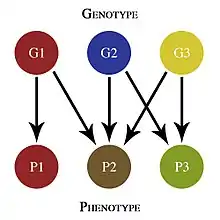Genotype–phenotype map
The genotype–phenotype map is a conceptual model in genetic architecture. Coined in a 1991 paper by Pere Alberch,[1] it models the interdependency of genotype (an organism's full hereditary information) with phenotype (an organism's actual observed properties).

A very simple genotype-phenotype map that only shows additive pleiotropy effects.
Application
The map visualises a relationship between genotype & phenotype which, crucially:[2]
- is of greater complexity than a straightforward one-to-one mapping of genotype to/from phenotype.
- accommodates a parameter space, along which at different points a given phenotype is said to be more or less stable.
- accommodates transformational boundaries in the parameter space, which divide phenotype states from one another.
- accounts for different polymorphism and/or polyphenism in populations, depending on their area of parameter space they occupy.
References
- Alberch, Pere. "From genes to phenotype: dynamical systems and evolvability". Retrieved 18 October 2020.
- Pigliucci, Massimo. "Genotype–phenotype mapping and the end of the 'genes as blueprint' metaphor". Retrieved 18 October 2020.
This article is issued from Wikipedia. The text is licensed under Creative Commons - Attribution - Sharealike. Additional terms may apply for the media files.